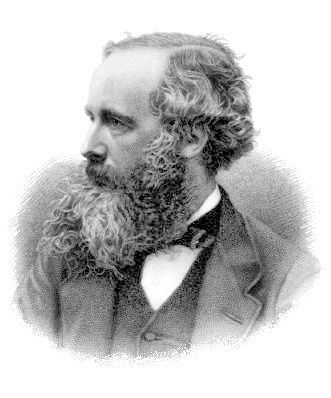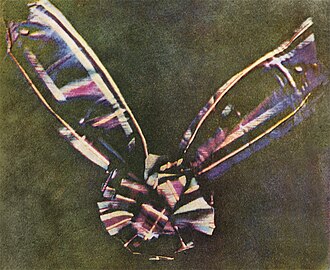James Clerk Maxwell
From Wikipedia, the free encyclopedia
| James Clerk Maxwell | |
|---|---|

James Clerk Maxwell (1831–1879)
| |
| Born | 13 June 1831 Edinburgh, Scotland |
| Died | 5 November 1879 (aged 48) Cambridge, England |
| Citizenship | British |
| Nationality | Scottish |
| Fields | Physics and mathematics |
| Institutions | Marischal College, Aberdeen King's College London University of Cambridge |
| Alma mater | University of Edinburgh University of Cambridge |
| Academic advisors | William Hopkins |
| Notable students | George Chrystal |
| Known for | Maxwell's equations Maxwell distribution Maxwell's demon Maxwell's discs Maxwell speed distribution Maxwell's theorem Maxwell material Generalized Maxwell model Displacement current Maxwell coil Maxwell's wheel[1] |
| Notable awards | Smith's Prize (1854) Adams Prize (1857) Rumford Medal (1860) Keith Prize (1869–71) |
| Signature | |
James Clerk Maxwell FRS FRSE (13 June 1831 – 5 November 1879) was a Scottish[2][3] mathematical physicist.[4] His most notable achievement was to formulate the classical theory of electromagnetic radiation, bringing together for the first time electricity, magnetism, and light as manifestations of the same phenomenon. Maxwell's equations for electromagnetism have been called the "second great unification in physics"[5] after the first one realised by Isaac Newton.
With the publication of A Dynamical Theory of the Electromagnetic Field in 1865, Maxwell demonstrated that electric and magnetic fields travel through space as waves moving at the speed of light. Maxwell proposed that light is in fact undulations in the same medium that is the cause of electric and magnetic phenomena.[6] The unification of light and electrical phenomena led to the prediction of the existence of radio waves.
Maxwell helped develop the Maxwell–Boltzmann distribution, a statistical means of describing aspects of the kinetic theory of gases. He is also known for presenting the first durable colour photograph in 1861 and for his foundational work on analysing the rigidity of rod-and-joint frameworks (trusses) like those in many bridges.
His discoveries helped usher in the era of modern physics, laying the foundation for such fields as special relativity and quantum mechanics. Many physicists regard Maxwell as the 19th-century scientist having the greatest influence on 20th-century physics. His contributions to the science are considered by many to be of the same magnitude as those of Isaac Newton and Albert Einstein.[7] In the millennium poll—a survey of the 100 most prominent physicists—Maxwell was voted the third greatest physicist of all time, behind only Newton and Einstein.[8] On the centenary of Maxwell's birthday, Einstein himself described Maxwell's work as the "most profound and the most fruitful that physics has experienced since the time of Newton".[9]
Scientific legacy
Electromagnetism

A postcard from Maxwell to Peter Tait.
Maxwell had studied and commented on electricity and magnetism as early as 1855 when On Faraday's lines of force was read to the Cambridge Philosophical Society.[85] The paper presented a simplified model of Faraday's work and how the two phenomena were related. He reduced all of the current knowledge into a linked set of differential equations with 20 equations in 20 variables. This work was later published as On physical lines of force in March 1861.[86]
Around 1862, while lecturing at King's College, Maxwell calculated that the speed of propagation of an electromagnetic field is approximately that of the speed of light. He considered this to be more than just a coincidence, commenting, "We can scarcely avoid the conclusion that light consists in the transverse undulations of the same medium which is the cause of electric and magnetic phenomena."[54]
Working on the problem further, Maxwell showed that the equations predict the existence of waves of oscillating electric and magnetic fields that travel through empty space at a speed that could be predicted from simple electrical experiments; using the data available at the time, Maxwell obtained a velocity of 310,740,000 metres per second (1.0195×109 ft/s).[87] In his 1864 paper A dynamical theory of the electromagnetic field, Maxwell wrote, "The agreement of the results seems to show that light and magnetism are affections of the same substance, and that light is an electromagnetic disturbance propagated through the field according to electromagnetic laws".[6]
His famous equations, in their modern form of four partial differential equations, first appeared in fully developed form in his textbook A Treatise on Electricity and Magnetism in 1873.[88] Most of this work was done by Maxwell at Glenlair during the period between holding his London post and his taking up the Cavendish chair.[54] Maxwell expressed electromagnetism in the algebra of quaternions and made the electromagnetic potential the centrepiece of his theory.[89] In 1881 Oliver Heaviside replaced Maxwell’s electromagnetic potential field by ‘force fields’ as the centrepiece of electromagnetic theory. Heaviside reduced the complexity of Maxwell’s theory down to four differential equations, known now collectively as Maxwell's Laws or Maxwell's equations. According to Heaviside, the electromagnetic potential field was arbitrary and needed to be "murdered".[90] The use of scalar and vector potentials is now standard in the solution of Maxwell's equations.[91]
A few years later there was a debate between Heaviside and Peter Guthrie Tait about the relative merits of vector analysis and quaternions. The result was the realisation that there was no need for the greater physical insights provided by quaternions if the theory was purely local, and vector analysis became commonplace.[92] Maxwell was proven correct, and his quantitative connection between light and electromagnetism is considered one of the great accomplishments of 19th century mathematical physics.[93]
Maxwell also introduced the concept of the electromagnetic field in comparison to force lines that Faraday described.[94] By understanding the propagation of electromagnetism as a field emitted by active particles, Maxwell could advance his work on light. At that time, Maxwell believed that the propagation of light required a medium for the waves, dubbed the luminiferous aether.[94] Over time, the existence of such a medium, permeating all space and yet apparently undetectable by mechanical means, proved impossible to reconcile with experiments such as the Michelson–Morley experiment.[95] Moreover, it seemed to require an absolute frame of reference in which the equations were valid, with the distasteful result that the equations changed form for a moving observer. These difficulties inspired Albert Einstein to formulate the theory of special relativity; in the process Einstein dispensed with the requirement of a stationary luminiferous aether.[96]
Maxwell's Equations:
| Name | Integral equations | Differential equations |
|---|---|---|
| Gauss's law | ||
| Gauss's law for magnetism | ||
| Maxwell–Faraday equation (Faraday's law of induction) | ||
| Ampère's circuital law (with Maxwell's addition) |
Colour analysis
Maxwell contributed to the field of optics and the study of colour vision, creating the foundation for practical colour photography. From 1855 to 1872, he published at intervals a series of valuable investigations concerning the perception of colour, colour-blindness, and colour theory, being awarded the Rumford Medal for On the Theory of Colour Vision.[97]
In the course of his 1855 paper on the perception of colour, Maxwell proposed that, if three black-and-white photographs of a scene were taken through red, green and blue filters and transparent prints of the images were projected onto a screen using three projectors equipped with similar filters, when superimposed on the screen the result would be perceived by the human eye as a complete reproduction of all the colours in the scene.[98]
During an 1861 Royal Institution lecture on colour theory, Maxwell presented the world's first demonstration of colour photography by this principle of three-colour analysis and synthesis. Thomas Sutton, inventor of the single-lens reflex camera, did the actual picture-taking. He photographed a tartan ribbon three times, through red, green, and blue filters, as well as a fourth exposure through a yellow filter, but according to Maxwell's account this was not used in the demonstration. Because Sutton's photographic plates were in fact insensitive to red and barely sensitive to green, the results of this pioneering experiment were far from perfect. It was remarked in the published account of the lecture that "if the red and green images had been as fully photographed as the blue," it "would have been a truly-coloured image of the riband. By finding photographic materials more sensitive to the less refrangible rays, the representation of the colours of objects might be greatly improved."[62][99][100] Researchers in 1961 concluded that the seemingly impossible partial success of the red-filtered exposure was due to ultraviolet light. Some red dyes strongly reflect it, the red filter used does not entirely block it, and Sutton's plates were sensitive to it.[101]
Kinetic theory and thermodynamics

Maxwell's demon, a thought experiment where entropy decreases.
Maxwell also investigated the kinetic theory of gases. Originating with Daniel Bernoulli, this theory was advanced by the successive labours of John Herapath, John James Waterston, James Joule, and particularly Rudolf Clausius, to such an extent as to put its general accuracy beyond a doubt; but it received enormous development from Maxwell, who in this field appeared as an experimenter (on the laws of gaseous friction) as well as a mathematician.[102]
Between 1859 and 1866, he developed the theory of the distributions of velocities in particles of a gas, work later generalised by Ludwig Boltzmann.[103][104] The formula, called the Maxwell–Boltzmann distribution, gives the fraction of gas molecules moving at a specified velocity at any given temperature. In the kinetic theory, temperatures and heat involve only molecular movement. This approach generalised the previously established laws of thermodynamics and explained existing observations and experiments in a better way than had been achieved previously. Maxwell's work on thermodynamics led him to devise the thought experiment that came to be known as Maxwell's demon, where the second law of thermodynamics is violated by an imaginary being capable of sorting particles by energy.[105]
In 1871 he established Maxwell's thermodynamic relations, which are statements of equality among the second derivatives of the thermodynamic potentials with respect to different thermodynamic variables. In 1874, he constructed a plaster thermodynamic visualisation as a way of exploring phase transitions, based on the American scientist Josiah Willard Gibbs's graphical thermodynamics papers.[106][107]

